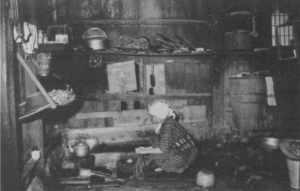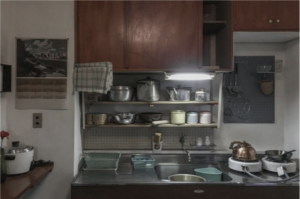In Laura Neitzel’s book, The Life we Longed For: Danchi Housing and the Middle-Class Dream in Postwar Japan, she highlights how the seemingly mundane kitchen sink holds its own rich history. Its history, she contends, serves as a poignant reflection of the evolving ideas surrounding home, family life, and the relentless pursuit of ‘modern living.’1 As she briefly touches upon the centrality of the stainless steel sink, this discussion endeavours to delve deeper into the narrative, offering a more comprehensive analysis that unveils the transformative role that specific amenities have on shaping the function of a space. In this case, this narrative will form around the transformative role that the stainless steel sink had on postwar middle-class women in Japan.
Neitzel’s exploration focuses on the pivotal role played by the Japan Housing Corporation (JHC) in the formation of Danchi apartment complexes – a development that unraveled the very fabric of middle-class life in postwar Japan. Neitzel identifies that the danchi served as a test bed for housing technology development, which played a pioneering role in standardising and modernising interior living spaces. This book is nestled in the broader historical context of the aftermath of World War II. The war left Japan’s urban areas in ruins, promoting an urgent need for reconstruction. Recognising the significance of housing in this rebuilding process, the Japanese government established the JHC in 1955. Its primary focus was on finding innovative solutions emblematic of a new era of modern living.2
Enter Miho Hamaguchi, a notable architectural visionary, whose influence in the 20th century has come to resonate through time. Neitzel mentions the work of Miho Hamaguchi and highlights her seminal 1950 book, The feudalism of the Japanese Home, which pioneer a paradigm shift in architectural planning. In this work, she advocated for a non-hierarchical planning, seeking after an egalitarian society without gender or class difference and believed that residential design was the tool to achieve this. The JHC recognised the potential of Miho Hamaguchi ideas and sought her collaboration.3 Indeed, Hamaguchi’s architectural philosophy, rooted in the rejection of hierarchical structures, aligned with the ethos of the danchi and became a successful collaboration that became a catalyst for change. Together, the work of Hamaguchi and the designs for the danchi breathed in a new design of space where residents could coexist harmoniously, liberated from the constraints of historical hierarchies.
What exactly was the role of the sink? How did the incorporation of a stainless steel sink symbolise ‘modernity’?
Hamaguchi assertion, as reiterated by Neitzel, ‘before the stainless-steel sink was put in, the dining-kitchen (DK) was a horrible place.’4 Indeed, the stainless steel-sink brought in a new aesthetic that helped to alter the entire function, practicality and efficiency of the kitchen.
Figure 1 captures the pre-stainless steel sink era, depicting a typical rural kitchen characterised by an uninviting ambiance. The image showcases an earthen floor, a lock of proper storage for pots, minimal lighting from a small window, and the absence of running water for dishwashing. (( Simon Partner, ‘Taming the Wilderness: The Lifestyle Improvement in Rural Japan, 1925-1965,’ Monumenta Nipponica, 56:4 (2001), p. 493. )) It represents the inconvenient and unhygienic space typical of many pre-war Japanese kitchens.

Figure 1. An ‘unreformed’ rural kitchen, 19495

Figure 2. A stainless-steel kitchen module. A replica of an orginal interior of Tokiwadaira Danchi built around 1960.6
In stark contrast, figure 2 represents a radical departure – a visually enriched and efficiently designed space centred around the stainless-steel sink. This layout not only introduces aesthetics but also revolutionises the practicality of the space. With designated spaces for pots, food preparation and dishwashing, this image represents how Japanese women found emancipation from their traditional roles in housewife duties.
With the introduction of this stainless-steel sink, the space of the kitchen altered becoming more efficient, thus Japanese women found themselves doing less and now had more time for other cultural activities. Furthermore, the sink created more space which in the context of the danchi allowed for the development of ‘Dining-Kitchens’ (DK). This saw the introduction of Wester-style table and chairs placed next to the kitchen facilities which further liberated women from excess movement and enabled them to talk with family members while cooking.7
The significance of this amenity is profound, as the mere addition of a more aesthetically pleasing and efficient sink facilitated a shift in the entire dynamics of the kitchen space. This ushered in an era of modernity that not only enhanced the visual appeal but also facilitated subsequent developments, ultimately reshaping the traditional role of a housewife in Japan.
The two images help capture this development. As figure 1 evokes a poignant image of a housewife toiling in dim, unhygienic, and solitary conditions, creating an atmosphere where she was more like a servant to the kitchen than a master of her domain. Whereas, figure 1 highlights a change in her narrative as it evokes the housewife navigating a space that is not only safer and brighter but more efficient, allowing her to move beyond the realm of housewife duties, where some middle-class women got jobs.
Recognising the profound impact of specific amenities on a space is crucial to understanding the intricate tapestry of social and cultural change. In this context, the introduction of seemingly mundane elements, such as a kitchen sink, is a powerful analytical tool, to unveil the layers of transformation within the fabric of society. Indeed, one is able to understand a deeper transformation in the way that individuals perceive and interacted with their living spaces.
- Laura Neitzel, The Life we Longed For: Danchi Housing and the Middle Class Dream in Postwar Japan, (2016), p. 41. [↩]
- Neitzel, The Life we Longed For, p. xiv. [↩]
- Tatiana Knoroz, Dissecting the Danchi: Inside Japan’s Largest Postwar Housing Experiment , (2022), p. 65 [↩]
- Neitzel, The Life we Longed For, p. 42. [↩]
- Figure 1. An ‘unreformed’ rural kitchen, 1949, image in Simon Partner, ‘Taming the Wilderness: The Lifestyle Improvement in Rural Japan, 1925-1965,’ Monumenta Nipponica, 56:4 (2001), p. 493. [↩]
- Figure 2. A stainless-steel kitchen module. A replica of an orginal interior of Tokiwadaira Danchi built around 1960, image in Tatiana Knoroz, Dissecting the Danchi: Inside Japan’s Largest Postwar Housing Experiment , (2022), p. 69. [↩]
- Neitzel, The Life we Longed For, p. 43. [↩]